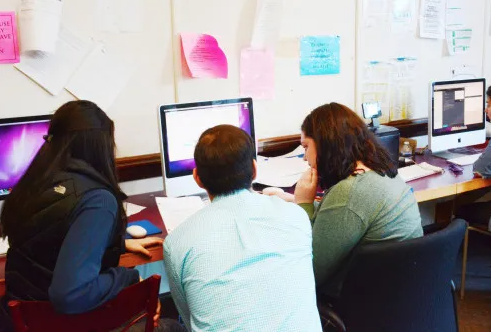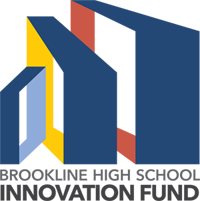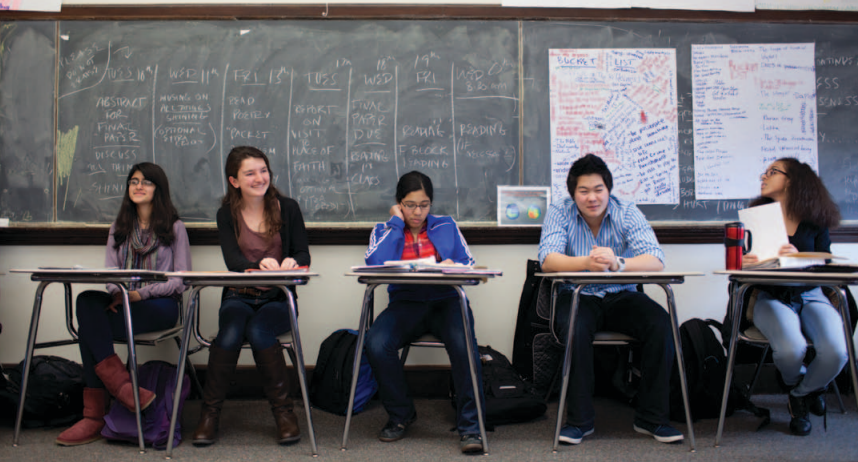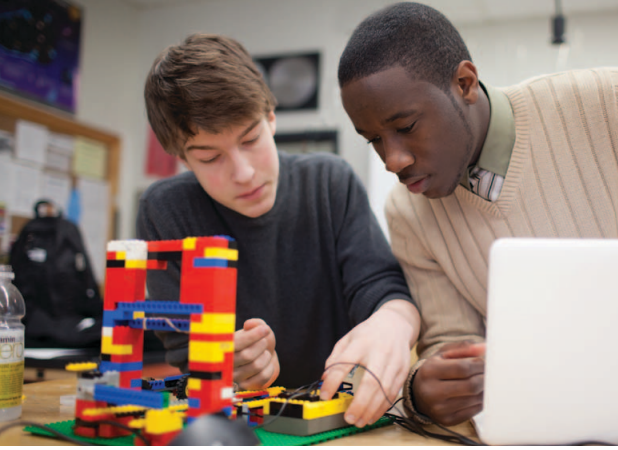
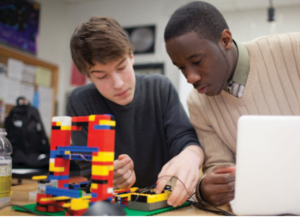 Strapped for cash, a Massachusetts high school starts its own venture fund to grow teacher leaders and encourage innovation.
Strapped for cash, a Massachusetts high school starts its own venture fund to grow teacher leaders and encourage innovation.
Test score gains and higher teacher satisfaction result.
In June 1998, two veteran teachers at Brookline High School stood before Headmaster Robert Weintraub’s desk asking for money. Gayle Davis and Margaret Metzger requested funding for an innovative teacher mentoring program, which promised to provide skills and institutional knowledge to the next generation of BHS instructors.
To Weintraub, Davis, and Metzger, this idea was a no-brainer. Veteran teachers were retiring from BHS in large numbers, leaving the school in the hands of young and inexperienced newcomers. Weintraub agreed that a program for new teachers was essential, but said the school simply did not have funds for mentoring. Limited funding also stymied efforts to address other critical problems at the school. Class size and an achievement gap in its diverse student body were constant challenges. Located in a large town on the outskirts of Boston, the school’s 1,800 students came from 76 countries, spoke 36 languages, and spanned the socioeconomic spectrum. An additional 5% of students commuted from Boston as part of a state- funded school desegregation program. Significant academic achievement gaps existed between white and Asian students and black and Hispanic students, yet the budget had insufficient funds to address this burgeoning problem.
In today’s economic climate, school leaders are no strangers to the predicaments Weintraub faced over 10 years ago. As some schools struggle to develop new programs to resolve pressing issues, others lack funding for even the most basic school supplies, technology, personnel, and building maintenance. School administrators frequently fill the void by developing creative partnerships with private donors, religious institutions, foundations, federal and state governments, and local businesses. While relationships between public schools and private sectors bring much needed funding, they also cause controversy. For instance, parents question whether private corporations like Coca-Cola or Nike should be allowed to advertise in school cafeterias and gyms in exchange for donations. In one case, parents in Nashville, Tenn., were irked when a local high school accepted $150,000 from the Tennessee Credit Union in exchange for opening a bank branch in the school’s cafeteria (Levitz & Simon, 2010). There is much to resolve about the nature of these public-private relationships.
An innovative solution
In 1998, Weintraub found himself gravitating towards a private-sector solution to Brookline High’s problems. After inviting 10 prominent community members to participate in a “think tank,” the concept of a 21st-century fund emerged. It called for successful community leaders to join school officials in developing a nonprofit venture capital organization based in the high school. Relying entirely on donations from alumni, parents, community members, and foundations, the fund would create and support innovative academic and social programs at BHS. The fund would allocate money to enable teachers to implement programs designed to solve serious problems at the high school, in the hope that successful teacher-initiated programs might eventually serve as models for other school districts.
But it was unclear how such a large sum of money could be collected. In the past, BHS received support from a few local philanthropists, its Parent Teacher Organization, and the Brookline Education Fund (BEF), but those donations weren’t enough to meet the school’s most urgent needs, nor were they directed to underwriting innovative programming.
Weintraub was intrigued by the fundraising capabilities of private schools and universities, which raised millions of dollars annually from alumni and constituents. Like those institutions, BHS was well-regarded by community donors; however, the school lacked the organizational structure to collect and distribute private funding.
To overcome these challenges, Weintraub sought buy-in from district leaders and start-up money. He invited the superintendent and members of the Brookline School Committee to participate in the fund’s design. A group of well-connected town residents, several with experience in philanthropic fundraising, planned a kickoff event for December 1998. This steering committee gained financial commitment from many local alumni before the event and raised over $500,000 for what became the 21st Century Fund, which registered itself as a 501(c)(3) nonprofit organization capable of providing tax exemptions to donors. The committee crafted a mission statement to make clear that the 21st Century Fund would provide venture capital to pilot innovative programs — designed by BHS teachers and Brookline community members — responding to national problems in public education. Brookline High would be a beta site, a laboratory for innovation in public education. Money in hand, the 21st Century Fund established an office in the high school and prepared to select the organization’s founding programs.
Teachers were empowered to consider the challenges they faced daily and to propose solutions to Weintraub and his team. Over time, a formal process for selecting programs evolved, a democratic system of approval was established, and more people took ownership of the organization. A program committee consisting of parents, community leaders, and school administrators was organized to vet proposals and support teachers through the application process. Teachers were required to submit realistic budgets for their programs, along with descriptions of how proposed initiatives would solve problems at BHS. The process was competitive, with only the most impactful proposals selected by the program committee. If chosen, teachers presented their ideas to the superintendent and central office officials to assure consistency with district goals. Next, proposals went before the 21st Century Fund’s board of directors, and ultimately the school committee for final approval.
Selected programs were designed to be financially supported for a three-year test period, and teacher leaders were relieved of one or two classes for program development and implementation. Time is an important commodity for teachers, and partial release from teaching assignments was a valued and essential component of the fund’s projects. With released time came high expectations for performance; teacher leaders were required to use valid research techniques to document the program’s success. Teachers presented data to the 21st Century board and district administrators, who closely examined whether programs met their objectives and determined whether to incorporate them into the
system’s long-term budget. An unsuccessful program received no further funding and was discontinued.
In September 2000, the 21st Century Fund financed its first program. Davis and Metzger launched their Teachers Mentoring Teachers program to promote teacher retention and professional growth. Over the next 10 years, the fund added 15 programs. A tutorial program established in 2002 provides individualized, content-based support to enhance the academic performance of students with mild learning disabilities. In 2003, the fund helped develop the African-American Scholars program to narrow the achievement gap by establishing and nurturing a corps of academically outstanding African-American students. More recently, a Social Justice Leadership Program was established to provide students with the skills needed to become active agents of change in a deeply divided world. Each of these programs sought to improve the lives of students at BHS while providing teachers with authentic opportunities for leadership.
Implementation challenges
The 21st Century Fund encountered significant challenges in its early years and is still a work in progress. One early controversy involved leadership. Some school officials and parents expressed concern that private donations might end up in an unregulated “slush fund” for the headmaster. Others questioned whether community leaders with expertise in business and academia, but limited experience with education might support programs inconsistent with the district’s goals. To address both concerns, the fund developed a highly inclusive governance structure. Multiple boards consisting of parents, community members, alumni, school leaders, and elected officials regulate donations and select new
programs. This inclusiveness ensured that the 21st Century Fund was a unified democratic effort, supported by all.
Another challenge is integrating successful programs into the regular school budget. Teachers Mentoring Teachers, for example, costs about $30,000 per year (the cost of two teachers relieved of one class each). School administrators must somehow find the money for the program, usually by reallocating resources to support the new successful program. This process became particularly daunting when the school district experienced increased enrollment at a time of economic contraction. To address this issue, Weintraub and Brookline Superintendent William Lupini look ahead when reviewing program proposals.
“We only want the 21st Century Fund to establish programs that will be sustainable under the regular budget after the three-year process has run its course. Otherwise, we might run into a situation in which excellent programs can’t be funded,” Lupini said.
The unpredictable economy makes planning difficult and requires Weintraub and Lupini to modify the budget frequently when adopting new 21st Century Fund programs. Over the first 10 years, BHS incorporated about $900,000 in programs, while reducing the rest of the budget by nearly that amount.
This is an essential component of the whole process; without incorporating successful programs, there would be no motivation to innovate.
Finally, the 21st Century Fund created some initial tension with existing local education groups and foundations. Before the fund’s inception, the high school PTO and Brookline Education Foundation (BEF) were the primary fundraising entities for Brookline schools, and there was concern that the new organization would compete for limited donations. To quell tensions, leaders of the fund and BEF agreed to create separate spheres for fundraising. The 21st Century Fund would exclusively seek donations from parents of high school students for innovative programming, while BEF could access K-8 families and fund teachers’ professional development. As a result of this productive communication, Brookline’s fundraising organizations developed a respectful and stable collaboration.
Fund benefits
Over 10 years, the benefits of the 21st Century Fund have become very clear to Brookline educators.
#1. Brookline is a leadership factory.
Since its inception, the 21st Century Fund has transformed the professional lives of BHS teachers. The leadership opportunities created by the fund’s programs engage, challenge, and invigorate faculty members.
“Developing a program from scratch and being selected to lead it was both validating as a professional and a tremendous professional growth opportunity for me,” said Davis, a coleader of Teachers Mentoring Teachers.
Christien Polos, teacher leader of an arts program for at-risk teenagers, agrees. “The 21st Fund has enabled me to work through, cultivate, and then realize an innovative idea that could possibly change a child’s path in life. Professionally, a person couldn’t ask for more validation from their workplace.”
Being selected as a teacher leader convinced some of the finest teachers at BHS to remain in the profession many years beyond their expectations. Metzger was ready to retire in 1998 after a 25-year career teaching English. Coleading Teachers Mentoring Teachers compelled Metzger to stay an extra 12 years. “I loved having ownership over an exciting new program and a new purpose. This opportunity was very affirming and made me feel extremely connected to the school,” Metzger said.
The 21st Century Fund also prepares the school’s next generation of administrators. While many teachers are content to be program leaders, others use newly acquired leadership skills to assume administrative positions. English teacher Mary Burchenal used 21st Century funds to develop an interdisciplinary program, The Good Citizen in a Good Society. Later, Burchenal was selected as English department chair. Brian Poon, a social studies instructor who also developed the Good Citizen program, became an associate dean and now directs an alternative program for at-risk students at BHS. “Good Citizen was really an entry point for me into how schools make change both on the institutional and the district level. I cultivated an appreciation for how a person gets things done in schools,” Poon said.
By providing leadership opportunities, the 21st Century Fund allows BHS to nurture and retain some of its brightest assets.
#2. The fund expanded student learning opportunities and produced impressive achievement results.
Students appreciate access to unique and innovative programs each year. “The 21st Century Fund provides us with so many interesting class and program options unavailable in other schools. . . . I love being a student here,” said one junior.
Students value the access to additional academic support, and they praise the 21st Century Fund for increasing classroom engagement. For example, the Engineering by Design course launched by the fund is popular among students who want a hands-on approach to the sciences. “I have a hard time keeping focused when I am lectured to all day. After doing this program, I feel like I can fix, design, or build anything. My favorite part of this program has been putting my creative mind into physical things,” said one student.
Increased student engagement coupled with new academic support programs have narrowed the achievement gap at BHS. Between 2005 and 2010, the number of African-American and Hispanic students scoring proficient/advanced on the Massachusetts Comprehensive Assessment System increased 84% for language arts and 71% for math. Class of 2011 students enrolled in the African-American Scholars Program (AASP) outpaced the national average on the SAT and outscored non-Hispanic white BHS students in the writing section. Most AASP students (68%) increase the number of honor and AP courses they take between freshman and senior year, and there was more than a 100% increase in the induction of AASP scholars into the National Honor Society in the last three years. While results demonstrate a significantly reduced achievement gap, there is still much work to be done. Future 21st Century Fund programs must remain committed to helping all students receive a challenging and meaningful education.
#3. The fund has deepened and expanded community involvement.
The fund also plays an instrumental role in involving parents in the school community. Research indicates that parental involvement in school peaks at the elementary level and tapers off as independence-seeking teenagers enter high school (Eccles & Harold, 1993). The 21st Century Fund invites parents to remain involved by participating behind-the-scenes on planning boards and committees and working on fundraisers. Each opportunity provides social interaction and a means for contributing to programming. This is a win-win situation: Parents connect to the school while contributing valuable resources and expertise.
In one case, volunteering for the 21st Century Fund inspired a parent to become a teacher. After chairing a 21st Century committee, Julie Joyal-Mowschenson was moved by “the tremendous efforts of BHS teacher-leaders to reduce inequalities at school and in the world.” Joyal-Mowschenson, a nationally respected nurse, earned a master’s degree in education, passed the Massachusetts teacher exam, and initiated a popular course at BHS called Medical Careers. She now also teaches that course at Boston’s Madison Park High School and plans to disseminate her curriculum in eight other Boston public high schools.
The fund provides exciting opportunities for another traditionally underinvolved group at the high school: alumni. Before the fund’s inception, the BHS alumni network was small and exclusively collected donations for class reunions. The fund expanded outreach to alumni by empowering them to raise money for venture capital programs. Many alumni enjoy sharing ideas and expertise from their professional lives with teacher leaders in developing new programs. For example, the Global Leadership Academy, a project currently under development, is receiving feedback from alumni leaders in business, law, and education. Through this involvement, many graduates have reconnected with their high school,
bringing valuable resources and ideas.
Finally, the fund attracts some of the community’s most generous philanthropists. Like parents and alumni, local donors have adopted leadership roles on various committees. They enjoy socializing with other community members and contributing expertise to support a good cause. As these philanthropists become more involved with the fund, they frequently make donations. Chobee Hoy, a local real estate agent and one of the fund’s most generous benefactors, said, “The fund inspires confidence and is a great draw for donors because it’s related to the school system, which is highly regarded and has excellent leadership.” The fund’s excellent reputation with the sponsors is especially critical in the current economic climate as aggregate charitable giving has declined or had only modest increases in recent years (Center on Philanthropy, 2011).
Conclusion
The 21st Century Fund model provides one formula for harnessing private funding in tough economic times. It is a luxury to raise funds for innovative programming at a time when other schools can barely afford teacher salaries and provide students with basic supplies. However, developing a local foundation is not something that is available only to the nation’s most affluent districts. Leaders of middle- and lower-income schools can also leverage the financial and human resources of their communities into powerful fundraising structures. While a town’s financial situation will inevitably dictate how much money a school can raise, all school leaders can create their own 21st-century funds.
Brookline’s 21st Century Fund continues to be a work in progress. Like any nonprofit organization, the fund regularly examines its mission and strategic plan to ensure future growth and success. The fund’s goal is to enable Brookline High to continue as a laboratory searching for innovative solutions to some of the nation’s most intractable educational challenges.
While problems such as teacher retention and the achievement gap can seem insurmountable, lessons from the fund’s successes and failures can contribute to national efforts for their resolution. As stated by one BHS parent and fund leader, “What inspires me about the 21st Century Fund is that it goes after major problems facing public high schools nationally, but it does so with very specific solutions that are applied and tested in one school. In the laboratory of innovation that is Brookline High School, we have
proven that you can attack some of these problems successfully one student at a time.”
References
Center on Philanthropy at Indiana University. (2011).
Giving USA 2011: The annual report on philanthropy for the year
2010. Chicago, IL: Giving USA Foundation.
Eccles, J.S. & Harold, R.D. (1993). Parent involvement during
the early adolescent years. Teachers College Record, 94 (3),
568-587.
Levitz, J. & Simon, S. (2010, June 14). A school prays for help:
Towns tap businesses, churches to shore up budgets. The
Wall Street Journal
By Daniel G. Green
kappanmagazine.org
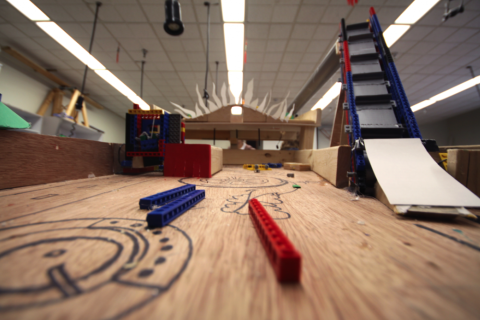
In Room 368, every table has a four-foot tall Rube Goldberg machine on it. In UA 11, saws, sanders and every other tool imaginable surround a few tables supporting the futuristic locker organizers students are building. These are the engineering rooms.
The school has two engineering classes: one run by the science department and one run by the career and technology education department. The two classes differ due to the role science plays in each class.
“Ninety-five percent of the time, the students are working and trying to solve problems,” said science teacher Aubrey Love, who teaches Engineering By Design, the science department’s engineering class. “I might be walking around and help a little bit here and there, but it’s really about what you can come up with through trial and error.”
Both classes focus on engineering, but Engineering By Design is more math- and physics- based than the elective class, Engineering the Future, according to Ed Wiser, the science department curriculum coordinator.
“It’s more hands on,” said Glen Gurner, of his Engineering the Future class. “I try to bring a little science into it. It’s more project-based, and it’s about making things and how to put things together.”
Both of the engineering classes follow the same design process of figuring out the problem, planning out what they are going to do, making a model, doing tweaks and then creating the final product, according to Wiser.
The Engineering By Design projects, however, require equations to help plan out every detail, according to senior Marshal Rekovskyson.
“Its a lot of physics,” Rekovskyson said. “Engineering requires a lot of physics because you need to know about the force needed to do something. We aren’t going to do calculations on the fly. Understanding the forces in effect, gravity and friction, definitely helps us make better machines.”
There is also a difference between the two classes in their access to large tools. The Engineering the Future class has access to all of the advanced tools in the basement of the Unified Arts Building, while the Engineering By Design class only uses the tools they have in their classroom and what the career and technology education department will give to them.
According to Wiser, Engineering the Future introduces fundamentals of engineering while Engineering By Design does projects that require more in-depth knowledge of engineering. Both aim to help students figure out whether or not engineering is something they want to pursue later in their life.
“We are given the freedom to do whatever we want and to add our own spin,” said Rekovskyson. “Most projects have strict guidelines and have a strict goal, but in this class, we just build.”
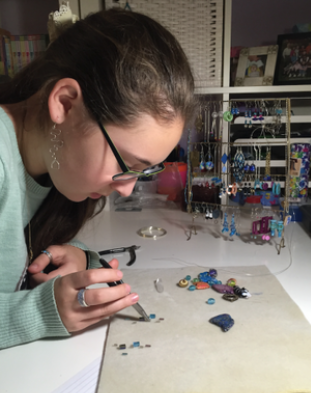
Bored with your math, science or Spanish class? There are three new classes that may be offered next year: A Human Math Experience, Drawing for the Understanding of the Field of Science and Medical Interpretation and Translation.
Every year, the 21st Century Fund introduces new programs and classes that are uncommon in high schools. This year, the program is hoping to fund these three new classes, two of which are not offered anywhere else in the country.
Faculty Leader of the Fund Gaelen Harrington has only good things to say about the new programs. She hopes that all of the planned classes will be initiated next year. If not, she intends to continue to push for these classes in the coming years.
“Part of our mission is that we see ourselves as an incubator of innovation,” said Harrington. “A proposal comes to us and we help it in its pilot phase of two, three, four years. If it is successful, we bring it to the school committee and ask the town to absorb it into its budget.”
A Human Math Experience will be about the application of mathematics outside of the classroom. According to Harrington, the unleveled class is not an average math class.
“The Human Math Experience arose out of math teachers’ concerns that so much of the teaching of math is to the test,” said Harrington. “Kids are taking math because it is required, or you want to take the AP exam, or you will take the MCAS or the SATs. There is not room in the school day to open kids up to real world application of math and the pure beauty of math. They wanted to offer a course that would provide that for kids,” Harrington said.
Mathematics Curriculum Coordinator Joshua Paris believes this class is different from other math classes for four main reasons: it gives insight into collegiate and professional math, it is not test-oriented, it is not constricted to the classroom and it is completely unleveled.
“I think that a lot of our classes use real world examples or questions, but more often than not, they are artificial,” said Paris. “This is the only place that will really look at what math is outside of the high school.”
Paris added that there will be projects and independent studies. He says that the students will not always be in their regular classroom because they will be using computers and visiting colleges. According to Paris, success in the course will commensurate with the level of dedication.
“It’s going to be about the effort you put into it,” said Paris. “As educators, that’s what we want. We want students who put in a lot of effort and invest their time to be successful.”
Unlike the math class, which is not taught in any other high school or college, the idea for Drawing for the Understanding of the Field of Science originated from a Harvard class which Donna Sartanowicz, an art teacher, and Jill Sifantus, a science teacher, took over the summer.
“One thing I love about it is that it breaks down the artificial wall between the arts and sciences,” said Harrington. “It’s really looking at drawing as a way of integrating and communicating knowledge. If you are doing field science and you are observing flowers or insects, you really get to know those thing if you are actually, pen in hand, drawing those things.”
Sartanowicz will be using her drawing skills and Sifantus her science knowledge to create a combined science-art class never seen before at the school.
“Both of us have our major interest. Mine in art, hers in science,” said Sartanowicz. “But both of us have an interest in the natural world. We are looking to collaborate by bringing in our separate strengths into a single course.”
The class will only count as an elective for the first year, but if it proves to teach the enrolled student a substantial amount of science, it will count for a science credit in subsequent years.
The new Spanish class, Medical Interpretation and Translation, also combines two subjects together: foreign language and science. This class was created to help students who are excelling in Spanish pursue their interest in other ways. These students will learn how to translate different medical terms from Spanish to English, and visa versa.
“It’s geared toward particular heritage speakers for whom the regular language course might not fit their level and sphere of skill,” said Harrington. “It is also geared towards very proficient Spanish speakers who are speaking it as a second language, who are looking for something more.”
This class is more than just a Spanish class. It offers an opportunity to learn about biology and Spanish while helping in the community. The students will be interacting with the Boston medical community by interning in hospitals and shadowing doctors as their Spanish interpreters and translators.
A common theme between these new classes is expanding the experience beyond the classroom. The math class visits colleges, the science-art class travels to fields and other locations, and the Spanish class works in a hospital.
“In this 21st century, in the world that we live in, I don’t think a class needs to be confined to four walls anymore,” said Paris. “One of the goals of this course is to remove those four walls from the classroom and to make it a more worldly class experience.”
